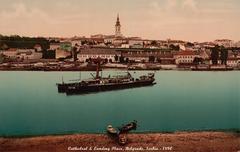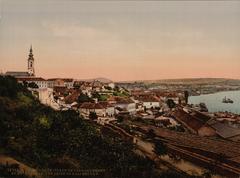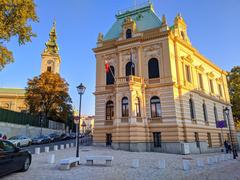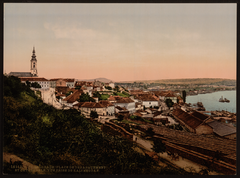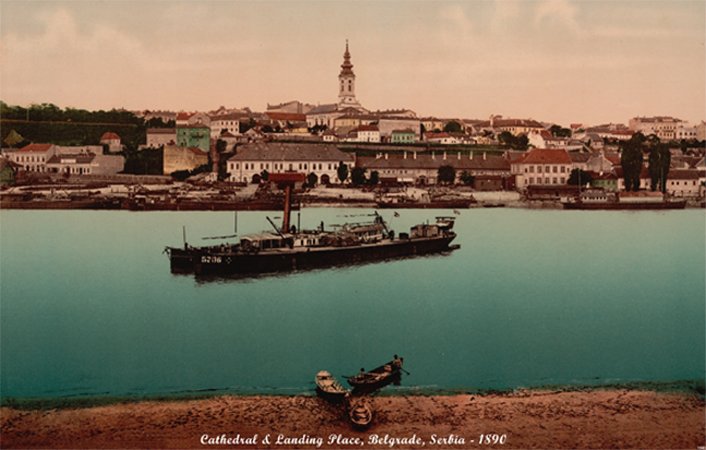
St. Michael’s Cathedral Belgrade: Visiting Hours, Tickets & Complete Guide to a Historical Landmark
Date: 14/06/2025
Introduction: The Significance of St. Michael’s Cathedral in Belgrade
St. Michael’s Cathedral (Saborna crkva Svetog arhangela Mihaila) is more than a place of worship—it’s a cornerstone of Serbia’s religious, cultural, and national identity. Built between 1837 and 1840, this Serbian Orthodox cathedral has stood through wars, political upheaval, and national rebirth. Its neoclassical and late Baroque architecture, rich interior artistry, and its role as a resting place for prominent historical figures make it an essential destination for anyone exploring Belgrade’s heritage (Balkan Kaleidoscope; Visit Belgrade). Situated in the heart of the historic district, the cathedral’s proximity to landmarks such as the Belgrade Fortress and Princess Ljubica Residence further cements its status as a must-visit site (Eyes on Belgrade; The Heart of Wandering).
Contents
- Historical Overview
- Early Foundations and Ottoman Era
- Construction and Architectural Style
- Role in Serbian National Awakening
- Burials and Memorials of National Figures
- Religious and Cultural Significance
- Preservation and Modern Recognition
- Visitor Information: Hours, Tickets, Tours, Accessibility
- Architectural Highlights: Exterior, Floor Plan, Interior
- Artistic and Cultural Treasures
- Bell Tower and Bells
- Restoration and Preservation
- FAQs
- Visual Gallery
- Visitor Tips and Summary
- Official Sources and Links
Historical Overview
Early Foundations and Ottoman Era
The cathedral stands on a site that has long been central to Serbian Orthodox life. The original church, dating back at least to the 18th century, was repeatedly destroyed and rebuilt during the Ottoman period, reflecting the turbulent history of the local Christian community (Wikipedia). The grounds also served as a major cemetery, highlighting the church’s role as a spiritual and communal anchor (Feel Belgrade).
Construction and Architectural Style
With Serbia’s push for autonomy, the current cathedral was built between 1837 and 1840, and consecrated in 1845 (Visit Belgrade). Adam Friedrich Quellfeldt designed the building in a neoclassical style, with pronounced late Baroque features—most notably in the soaring bell tower. The lavish interior was decorated by sculptor Dimitrije Petrović and painter Dimitrije Avramović, both trained in Vienna, whose work contributes to the cathedral’s artistic splendor (More Than Belgrade).
Role in Serbian National Awakening
During the 19th century, St. Michael’s Cathedral became a symbol of Serbian independence and national revival. It hosted state ceremonies, including royal coronations, and provided a focal point for both religious and civic gatherings. Its location, adjacent to the Patriarchate, Princess Ljubica Residence, and Belgrade Fortress, placed it at the heart of political and cultural developments (Eyes on Belgrade).
Burials and Memorials of National Figures
The cathedral is the burial place of national heroes such as Prince Miloš and Prince Mihailo Obrenović, reformer Vuk Karadžić, and Enlightenment leader Dositej Obradović. The presence of their tombs highlights the church’s dual role as both a spiritual center and a pantheon of Serbian identity (TripHobo; Balkan Kaleidoscope).
Religious and Cultural Significance
St. Michael’s Cathedral is home to a treasury of artifacts, including golden liturgical items, icons, and relics of revered saints (Feel Belgrade). The Belgrade Singers Society, founded here in 1853, continues the tradition of sacred music, underscoring the cathedral’s cultural influence (Balkan Kaleidoscope).
Preservation and Modern Recognition
One of the few major 19th-century monuments to survive in Belgrade, the cathedral was declared a Cultural Monument of Exceptional Importance in 1979 (Wikipedia). It remains a living center for worship, national ceremonies, and tourism (Visit Belgrade).
Visitor Information: Hours, Tickets, Tours, Accessibility
- Visiting Hours: Typically open daily, 9:00 AM–7:00 PM (may vary during religious events).
- Admission: Free entry; donations are welcome.
- Guided Tours: Available in English and Serbian; book in advance, especially during peak tourist seasons.
- Accessibility: Wheelchair accessible with ramps at the main entrance, though some historic features may limit full access.
Essential Visitor Tips
- Modest dress is required.
- Photography is permitted without flash, but be discreet and respectful.
- For the latest visiting hours, check the official website or city tourism sites.
Architectural Highlights
Exterior and Façade
The cathedral’s neoclassical façade features a prominent portico with Ionic columns and a triangular pediment. The 60-meter-high bell tower, capped with a baroque dome and gilded cross, is a defining element of Belgrade’s skyline (GPSmyCity).
Structural Layout and Floor Plan
Following a basilica layout, the spacious nave is flanked by side aisles and culminates in a semicircular apse. Robust columns and arches support upper galleries, and the clerestory windows flood the interior with natural light.
Interior Decoration and Iconostasis
The interior is a masterpiece of 19th-century Serbian art, with frescoes by Avramović and a monumental, gold-plated iconostasis by Petrović. The iconostasis, adorned with icons of Christ, the Virgin Mary, and saints, is both a liturgical and artistic center (GPSmyCity).
Artistic and Cultural Treasures
- Frescoes and Murals: Depicting scenes from the life of Christ and the saints, blending Byzantine and Western influences.
- Furnishings: Dark wood pews, a carved pulpit, and crystal chandeliers create an atmosphere of solemn grandeur.
- Relics and Treasures: Displayed in glass cases, including relics of Serbian saints and liturgical vessels.
Bell Tower and Bells
The cathedral’s bell tower houses five bells, cast in Pest in the 19th century. The largest, the “Great Bell,” weighs over two tons and is rung during major religious occasions. The tower is generally not open to the public due to safety and preservation concerns.
Restoration and Preservation
Major restorations in the 20th and 21st centuries have preserved the façade, roof, and interior frescoes. Maintenance addresses structural challenges, ensuring the cathedral’s longevity as a protected cultural monument (GPSmyCity).
Frequently Asked Questions (FAQ)
Q: What are the visiting hours?
A: Generally 9:00 AM–7:00 PM daily; check for updates around religious holidays.
Q: Is there an entrance fee?
A: No, entry is free; donations are appreciated.
Q: Are guided tours available?
A: Yes, in English and Serbian. Advance booking is suggested.
Q: Is the cathedral accessible?
A: There are ramps at the entrance; some areas may be less accessible due to the building’s age.
Q: Can I take photos?
A: Yes, without flash, and respectfully.
Visual Gallery
Caption: The neoclassical façade and bell tower of St. Michael’s Cathedral.
Caption: The gilded iconostasis depicting Orthodox saints.
Caption: View from the bell tower showcasing Belgrade’s cityscape.
Visitor Tips and Summary
- Dress modestly and respect the sacred space.
- Early morning or late afternoon visits offer optimal lighting and fewer crowds.
- Explore nearby sites: Belgrade Fortress, Princess Ljubica Residence, and Kalemegdan Park.
- Consider using the Audiala app for self-guided audio tours and up-to-date information.
St. Michael’s Cathedral is not only a highlight among Belgrade’s historical sites but also a living testament to Serbia’s resilience, faith, and artistry. Its legacy continues through religious services, cultural events, and the stories of the nation’s heroes buried within its walls (More Than Belgrade; Feel Belgrade; The Heart of Wandering).
Official Sources and Further Information
- St. Michael’s Cathedral Belgrade: History, Visiting Hours & Tickets – Balkan Kaleidoscope
- Wikipedia: St. Michael’s Cathedral, Belgrade
- Visit Belgrade: St. Michael’s Cathedral
- Eyes on Belgrade: Cathedral Church of St. Michael
- More Than Belgrade: Temple of St Archangel Michael
- Feel Belgrade: St Michael’s Cathedral
- GPSmyCity: Church of St. Archangel Michael
- The Heart of Wandering: St. Michael’s Cathedral
- The Crazy Tourist: St. Michael’s Cathedral, Belgrade
- TripHobo: St. Michael’s Cathedral, Belgrade
For the most current information on visiting hours, events, and guided tours, consult the official website of St. Michael’s Cathedral or the Belgrade Tourist Organization.
Take advantage of mobile resources like the Audiala app for interactive maps, audio guides, and travel updates to enrich your visit.
